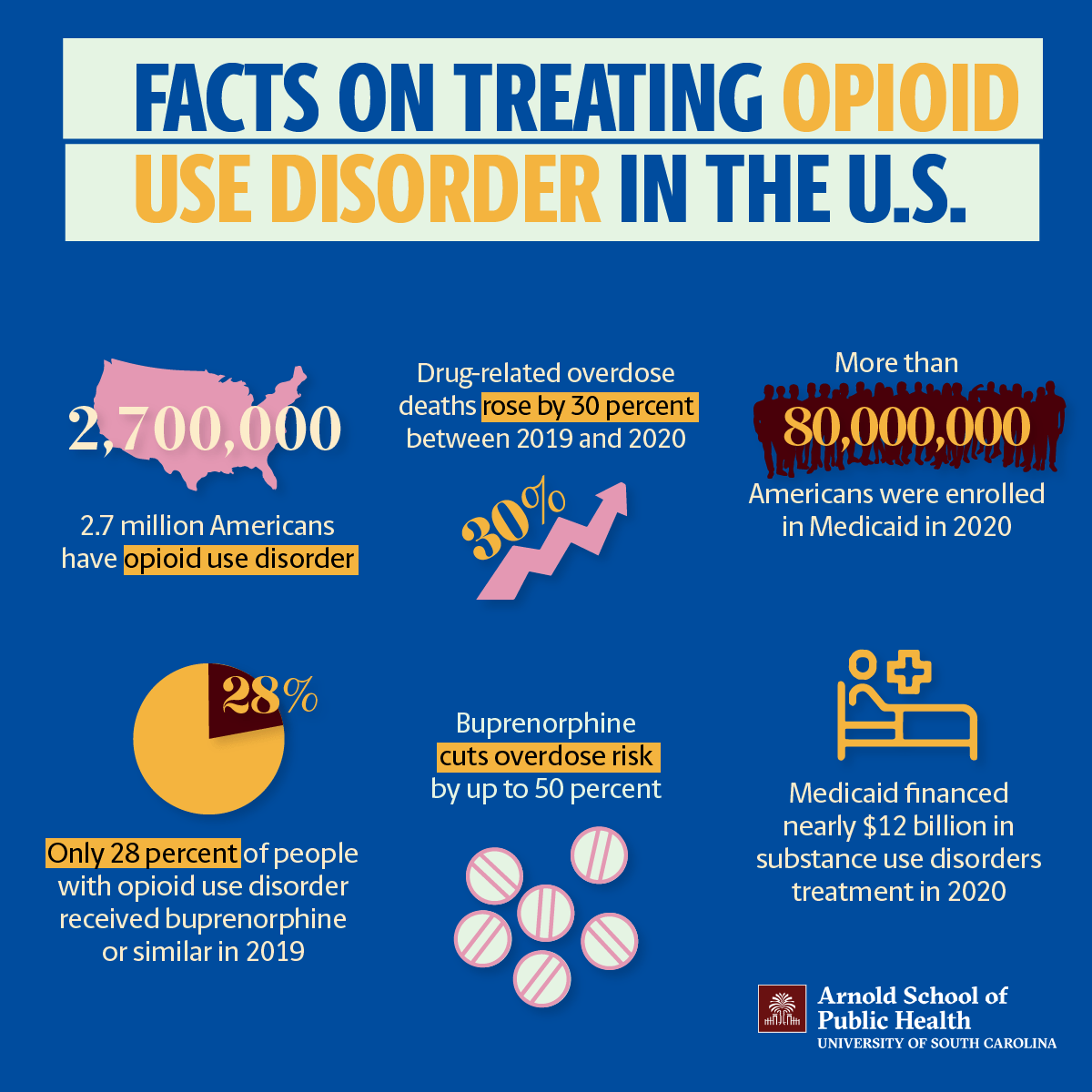
The study found substantial variation in prior authorization use among different states, particularly in the South, and based on plan type (for-profit vs non-profit) and partisan composition.
January 16, 2024 | Erin Bluvas, bluvase@sc.edu
In an analysis of comprehensive Medicaid-managed care plans, health services policy and management associate professor Christina Andrews and her team found substantial variation in prior authorization use among different states and plan types. Published in the January issue of Health Affairs, their study found that 11 states required prior authorization across all plans, and 13 states required no authorization. Another eight states employed a mix of requirements across plans. The researchers also discovered that for-profit plans and those located in Republican-majority states were more likely to impose prior authorization policies.
“Buprenorphine is a prescription drug that is one of the most effective treatments for opioid use disorder, yet only a quarter of Americans who need it receive it,” says Andrews, whose earlier research has identified prior authorization as an important barrier to accessing buprenorphine. “Our findings suggest that managed care plans’ decisions regarding use of prior authorization may be shaped by internal pressures to control costs as well as by differing partisan stances regarding the need to prevent criminal use of buprenorphine.”

The study found substantial variation in prior authorization use among different states, particularly in the South, and based on plan type (for-profit vs non-profit) and partisan composition.
The opioid crisis is the deadliest drug epidemic in U.S. history. In 2020, more than 10 million Americans misused opioids. Scientists estimate that more than a quarter of these individuals (2.7 million) have opioid use disorder requiring treatment.
Drug-related overdose deaths rose by 30 percent between 2019 to 2020 and by 14 percent from 2020 to 2021. This increase was driven primarily by opioid overdoses.
As one of three FDA-approved medications for the treatment of opioid use disorder, buprenorphine is a key tool for clinicians and public health professionals in addressing the opioid epidemic. The drug reduces the risk for relapse and deaths and cuts overdose risk by up to 50 percent.

Medicaid is one of the important policy levers available for providing access to this life-saving treatment, according to experts like Andrews. More than 80 million Americans were enrolled in its plans in 2020, and Medicaid is the largest payer of all substance use disorder treatment – financing nearly $12 billion in treatment services that same year.
However, only 28 percent of people with opioid use disorder received buprenorphine or one of its counterparts to treat their condition in 2019, even though the program covered 40 percent of this population. Why the gap?
“Treatment remains difficult to obtain,” Andrews says. “And our research aims to help
us understand the barriers and how to overcome them.”
In 2018, congress passed the Substance Use Disorder Prevention that Promotes Opioid Recovery and Treatment (SUPPORT) for Patients and Communities Act. This legislation mandated that all state Medicaid programs provide coverage for FDA-approved drugs in the treatment of opioid use disorder between 2020 and 2025.
However, the new law did not prohibit insurers from requiring prior authorization to fill these prescriptions. According to the researchers, this tactic can serve as a mechanism to control costs and act as a gatekeeper for determining which patients receive access to treatment.

43 percent of Medicaid plans require prior authorization for buprenorphine.
“Although prior authorization can be a useful tool to ensure appropriate clinical
care, it can also unnecessarily restrict access to buprenorphine through delays and
denials – resulting in missed opportunities to engage patients in treatment,” Andrews
says. “Previous studies have found that the removal of prior authorization leads to
an increase in receipt of buprenorphine, and its presence serves as a major barrier
to care. Thus, the widespread use of prior authorization for Medicaid-covered Americans
represents a substantial concern.”
Previous research has demonstrated that Medicaid practices are heavily influenced by the broader social and economic environments of each state. Last year, Andrews and her team published a study in Health Affairs that examined state funding cuts to opioid use disorder treatment. They found that funding allocations vary dramatically from state-to-state, often influenced by contextual factors such as politics.
With their most recent study, the researchers examined prior authorization practices across states by analyzing data from the 266 comprehensive Medicaid managed care plans available in 2018. The majority of these plans provided coverage for buprenorphine (Kansas did not provide coverage, and several other plans could not be verified). Among the remaining 256 plans, 43 percent required prior authorization.
The authors also observed clear differences in prior authorization use across states when looking at partisan composition of state legislatures. Democratic-majority states had significantly lower levels (seven to 22 percent for nonprofit vs for-profit plans) of prior authorization compared to Republican-majority states (69 percent of nonprofit plans and 70 percent of for-profit plans). Swing states revealed a mixed trend based on for-profit (67 percent) vs nonprofit (44 percent) status.
Partisan differences may be explained, in part, by concerns about the potential use of buprenorphine in illicit, secondary drug markets. While both major political parties have committed to expanding access to opioid use disorder treatment, Republicans have generally expressed more concern for the criminal use of buprenorphine.
“Access to buprenorphine for Medicaid enrollees is shaped not only by the state in which they live but also the particular plan in which they are enrolled,” Andrews says. “It remains unclear how unequal access to this lifesaving medication may affect opioid-related overdose and mortality for those affected.”